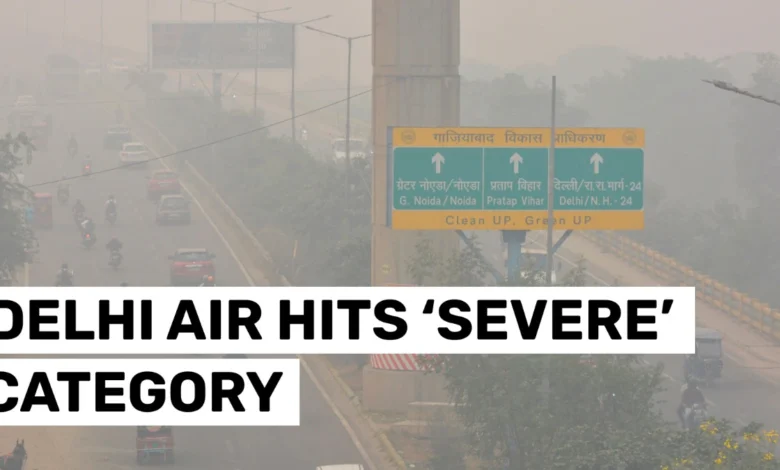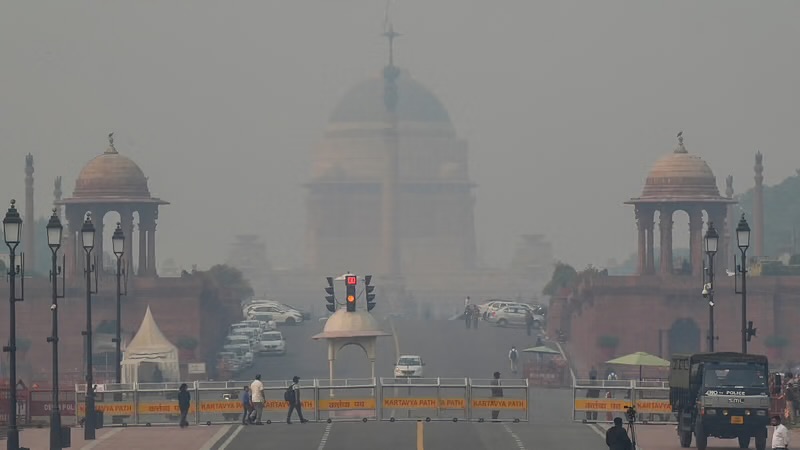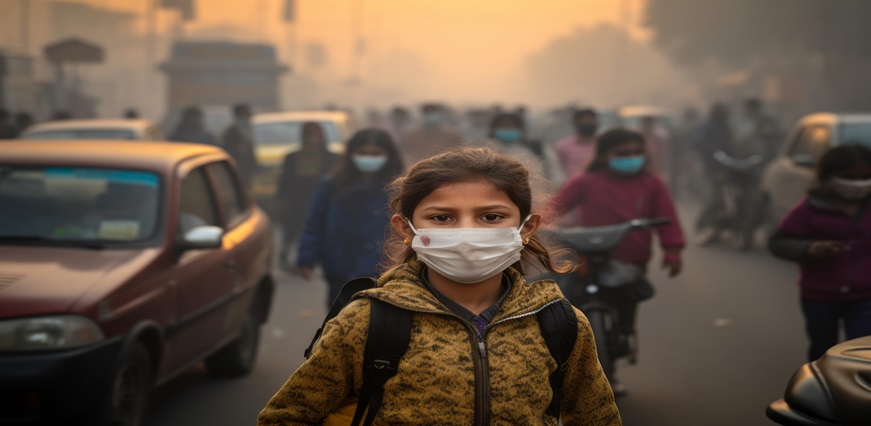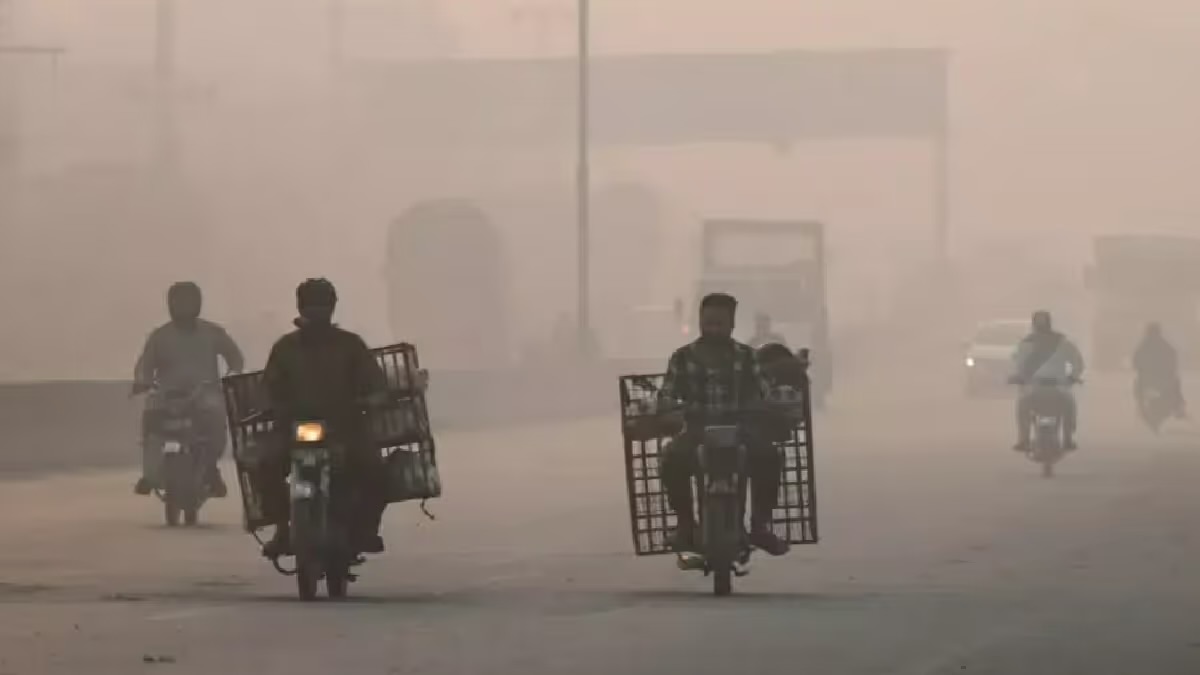The Dark Side Of Delhi’s Diwali Celebrations! Why Does Delhi Continue To Suffer From Toxic Air Pollution? Who’s Accountable For The Air People Forced To Breathe?
Recently, the Supreme Court of India has been very anxious about the enforcement of firecracker prohibition in Delhi, stating that the latter has been useless during times of deteriorating air quality. This article will take you through the nitty-gritty of air pollution in Delhi, why it is poor year after year, and its implications on public health and safety.

Delhi, the capital city of India, has become infamous for hosting one of the world’s worst air quality through the winter months. On 4 November 2024, the Supreme Court of India condemned the Delhi State Government for not implementing a blanket ban on the use of firecrackers. The government had banned Diwali fireworks, which was supposed to restrict this seasonal rise in pollution, but celebrations were once again marked by intense fireworks that added yet another layer to Delhi’s chronic air crisis. The Supreme Court took notice, summoning the Delhi Police Commissioner and the state’s administration to report on their efforts to enforce this ban.
This pollution, besides being visually smoky with hazy skies and streets blanketed in smog, has heavily affected the lives and health of millions, with extensive diseases from respiratory illness to poor quality of life, while also giving the city the title of being the most health hazard in the world. The day after Diwali, Delhi got its title as the world’s most polluted city, and its AQI went off the charts, hitting hazardous levels as the PM2.5 concentrations broke all-time records.
This article probes into why Delhi’s air is so polluted, how factors, visible and hidden, contribute to this crisis, and what the residents are paying with a heavy price. It also does an aggressive analysis of why the crisis continues even after the intervention by the government and what must be done to bring about change.
Factors Contributing to Delhi’s Poor Air Quality
Use of Firecrackers during Diwali
The most obvious reasons for spiking Delhi’s peak season include firecrackers used generally during Diwali celebrations. Firecrackers generate massive amounts of particulate matter (PM2.5 and PM10), sulphur dioxide, and many other toxic gases. PM2.5 is so small that it can get into the lungs and into the bloodstream and cause critical damage to the respiratory and cardiovascular systems.
The Supreme Court of 2017 has issued directions to ban the sale of firecrackers and their use in Delhi as well as other areas of its vicinity, particularly on the eve of the celebration of festivals. The court issued directions for a total ban, but the implementation side is taking fewer steps because people are importing firecrackers from other states or buying from local retailers who need a mechanism for monitoring. Border checks in Delhi are tight enough. The people usually host firecrackers in what is termed cultural expression and usually claim that this is their tradition, even if it ruins their environment.
The Supreme Court notice to the Delhi authorities underlines the gulf between policy and practice. The real question still remains: why can the government not really enforce this ban? Lack of workforce in the police force? Or is it a deeper cultural resistance? Whatever the reasons, this continued defiance of the cracker ban directly feeds into the alarming post-Diwali pollution spikes in Delhi.
Stubble Burning in the Neighboring States
This tradition has been ongoing since autumn every year when farmers of Punjab and Haryana begin clearing their fields by burning the stubble left after harvesting rice. It is economical and saves time for the farmers but it causes massive pollution levels in northern India. Wind carries the smoke directly to Delhi, where cooler temperatures and stagnant air prevent the dispersal of smoke and form a dense, toxic fog.
The government incentives and interventions toward reducing stubble burning have had little impact. While the Supreme Court, year after year, has ordered that the activities of Punjab and Haryana be curtailed and even penalised with a financial fine and supplying of eco-friendly machinery on the ground, nothing on the ground seems to alter. The majority of such farmers, who are generally economically disadvantaged, cannot afford it without being provided with suitable, short-term economic facilitation.
Systemic failure to deal with stubble burning is critical to Delhi’s air pollution. The Supreme Court’s recent order has asked the officials in Punjab and Haryana to give specific affidavits on particular incidents of stubble burning that have taken place within the last ten days of October. However, a clear fact is that there are no stronger agricultural policies and financial incentives, which means that this seasonal smoke blanket will continue to suffocate Delhi.
Meteorological Conditions and Seasonal Effects

Meteorology increases the level of pollution in Delhi by a great margin. In winter, an effect known as temperature inversion causes pollutants to get trapped close to the ground. Generally, warm air rises to leave room for other particles, including pollutants. An inversion, however, is where a layer of warm air rests on the ground and colder air underneath; hence, the pollutants are trapped.
Delhi’s natural impact is compounded by its geographical location. The city is landlocked and only offers a little in natural air-cleansing mechanisms, such as coastal winds, to help dissipate the pollution. The drier air, lower temperatures, and frequent wind stagnation characteristic of winter contribute to accumulating pollutants.
Urban Sources of Pollution: Traffic, Industry, and Construction
While the seasonal spikes from firecrackers and stubble burning add to the pollution problem, Delhi suffers from continuous yearly pollution due to urban sources. Vehicle emissions continue to form the core of the list as the population and vehicle numbers are still increasing. Trucks, buses, and millions of private cars generate carbon monoxide, nitrogen oxides, and a host of other pollutants which greatly degrade air quality.
Other major contributors to its pollution level are industrial pollution and construction dust. Although there are rules, many industrial belts continue to function without proper emission control. Scattered throughout the city, construction sites produce tons of dust, contributing to vehicle emissions and making it an even more noxious environment.
The Supreme Court has been periodically asking for better control over these sources, but the pace of change could be faster, showing the city is still trying to achieve a balance between development and environmental concerns.
Reasons for Continued Pollution
There are a large number of policies, bans, and orders by the Supreme Court, but on the ground level, there needs to be stronger enforcement. The government can always make a statement of crackdown or change in policy, but rarely does it happen at the grassroots level. Delhi Police and regulatory agencies are already short-staffed, and corruption only further dilutes the effect of action.
Public Apathy and Cultural Factors
Public apathy is one very important but often ignored cause of Delhi’s pollution problem. There are many air-polluted residents of Delhi who are not bothered about this issue, do not show any concern and are least responsible for environmental degradation. Festivals and cultural traditions often come above environmental concerns. Many feel it is an infringement of individual freedom when firecracker use or vehicle usage is banned or restricted. In fact, public participation becomes a bottleneck in any massive anti-pollution campaign.
Infrastructure Deficiencies
Delhi’s infrastructure is also contributing to the worsening pollution. The city needs to have adequate green cover to absorb pollutants; the parks and green belts are shrinking due to fast urban expansion. Public transportation infrastructure is improving but is still inadequate, with increasing private vehicles on the road. Waste management is another major issue; improper disposal methods contribute to the level of pollution. All these infrastructural deficiencies would need a massive overhaul of policies, funding, and public cooperation.
The toll on Public Health of the Rising AQI
Delhi is not an environmental matter alone; it is, in fact, a grave public health crisis among millions of residents. The rapid rise in the Air Quality Index (AQI) to hazardous levels, mostly during and after Diwali, poses disastrous health implications. As suggested by health scientists, long exposure to such high levels of PM2.5 and PM10 causes chronic respiratory diseases, cardiovascular diseases, and low quality of life.
Health Effects: Respiratory and Cardiovascular Effects
Air pollution in Delhi is mostly dominated by toxic pollutants, including PM2.5, PM10, sulphur dioxide, nitrogen oxides, and ozone. These particles can penetrate directly into the lungs, and via the bloodstream in particular, they cause inflammation and exacerbate asthma, bronchitis, and COPD.
For the residents of such an area, most vulnerable because it includes brain-impaired children, older adults, and those with other serious health issues, toxic air may equal smoking several packs of cigarettes a day. Exposed to high levels of PM2.5, various studies indicate long-term continuous exposure has been shown to decrease lung function, cause damage to the breathing system, and even lead to respiratory failure in extreme cases.
AQI levels are increasingly high among heart patients, which increases their chances of a heart attack, stroke, and many other cardiovascular conditions. LocalCircles is a public opinion platform; it reports that about 69 per cent of families here have a member suffering from respiratory issues because of the air quality. Children, in particular, who are more susceptible to air pollution show wheezing, coughing, and lung infections almost every other winter.
Case Study of Affected Persons

Rekha Sharma is a 52-year-old resident of Anand Vihar whose serious health issues are a result of the poisonous air in Delhi. Rekha had asthma ten years back, but in the past five years, her problem has worsened to the extent that her condition almost exactly mirrors the increase of AQI in Delhi year after year. She is an extremely energetic child, yet her locality, Anand Vihar, is known for being among the city’s highest pollutant regions, mostly because of high traffic movement, industrial activity nearby, and proximity to construction zones.
Around late October to November, with the chill getting into the climate and increasing pollutants in the atmosphere, Rekha’s situation worsens enough that she has to consume her inhaler for a couple of hours. The past few years had turned her life into a cycle of inhaler use, constant doctor visits, and severe bouts of breathlessness. She wakes up gasping in the middle of the night, though she has an air purifier at home. “There are nights I feel like I’m suffocating.”. I have to sit up and struggle for some time to catch my breath, she says, speaking of the terror of running out of breath.
She tried to cope with it by putting air purifiers in multiple rooms in their house at a cost over 60,000 rupees ($800), as the air purifiers she has bought offer minimal consolation. Her doctor has advised her to stay indoors as much as possible, especially during the peak pollution hours of early mornings and late evenings. This also limits her movements severely. She enjoys morning walks in local parks; now stepping outside could provoke an asthma attack.
The cost for Rekha’s family is prohibitively expensive. In addition to the air purifiers, they pay an average of 5,000 rupees, or $60, monthly for her medication and consultation. Her husband, a retired government employee, dreads the long-term financial fallout but fears far more for her health. “Every winter, I fear for her life,” he confessed. “We have thought of moving out of Delhi, but our lives and our children’s lives are here.”
It is not only the physical health aspect; it is also mental because, for families with little kids or elderly relatives, this constant worry about the quality of air brings forth anxiety and stress. As the amount of change that occurs from time to time is unpredictable, it becomes like living in a hyper-vigilant mode because they check AQI every day and tend to stay indoors, thus hampering mental well-being and social interactions.
Why Is This Crisis Continuing?
Delhi’s air is in a systemic crisis which will not be fixed by anything less than Diwali fireworks or stubble burning. In a way, it’s a persistence of a combination of failures of the governance system, weaknesses of regulations, some cultural practices, and, above all, a deficiency in public responsibility.
The most important reason for Delhi’s pollution problem is that anti-pollution measures need to be implemented uniformly. Firecracker bans, vehicle emissions checks, and industrial pollution checks are measures still followed in fits and starts. The policies announced by the authority go without due application on the ground.
The government enforces temporary bans, odd-even vehicle schemes, and other emergency measures every year when pollution peaks. It is a short-term remedy. Long-term strategies with dedicated budgets are needed for over-reliance on private vehicles, industrial pollution, and insufficient green cover.
Most citizens feel that it is unnecessary to bring down the city’s pollution load, but prefer to adopt a traditional or convenient approach even though they violate all environmental and social good sense. It has been observed that people burst crackers with religious fervour during the Diwali season even when the high court bans it strictly, without a sense of violation.
Overall, most citizens of the country feel that this is a negation of their cultural rights. It is equally scarce to get the residents to cut down on the usage of vehicles and become more conscious about being green and non-polluting.
Massive infrastructural investment is required for the control of pollution. Delhi is a city where waste disposal and public transportation infrastructure do not match the scale. The public transport system needs to be improved to absorb the sheer population of the city; hence, there is too much reliance on private transport.
Similarly, there needs to be more waste disposal infrastructure leading to unauthorised burning of waste, which results in emissions of toxic gases. There needs to be more adequate investment in green infrastructure and renewable sources of energy to keep the air quality worsening for Delhi.
This stubble burning by farmers in neighbouring states is not driven by another desire but by the lack of alternative feasible options. Though the governments have given incentives for machines that process the stubble, adoption is very low because costs are very high and logistically challenging for farmers who are already marginalised by economic conditions. Unless proper practical and accessible alternatives become available, stubble burning will continue to poison Delhi’s air each winter.
What Should Be Done?

This would only be done with the government alone, but the change in the behavior of public and societal norms is a must.
The authorities have to act with zero tolerance for those violating, which may either be the people creating fireworks or the industrial units violating emission standards. This monitoring, especially during peak seasons, will deter some of these violators and help the culture develop about being answerable.
The expansion of the public transport network and its usage will reduce vehicular emissions drastically. Green spaces like parks and tree-lined roads enhance air quality as a natural buffer. Government incentives must also be promoted for the usage of electric vehicles through incentives for adoption and more installations of charging infrastructure.
Education is required for long-term change. The government should bring public awareness throughout the year about how pollution is a health hazard to man and his environment. Modules should be included in school curricula to teach future generations about environmental responsibility. It should be made known to citizens that controlling pollution is a collective responsibility.
Reducing stubble burning will also be possible if the government offers cheaper and more accessible alternatives to farmers. There is an increase in the provision of subsidies, provision of financial incentives, deployment of equipment that converts stubble into biofuel or compost, and working in collaboration with agronomists and environmental scientists who might bring out innovative solutions for environmental benefit and the livelihood of the farmers.
The government should ensure that real-time air quality data across more locations is transparently provided. Such data and health advisories and alerts can be regularly published to help citizens make proper choices regarding outdoor activities in reducing exposure to polluted air.
Delhi can always live with festivals but it’s high time they adopt greener ways to celebrate festivals. Diwali celebrations can be held without the pollution of their surroundings through eco-friendly lights, soundless fireworks, and community gatherings without firecrackers. Religious leaders and cultural icons can help make it popular and ask the citizens to bring a balance between tradition and environmental responsibility.
Urgent Steps Needed for a Breathable Delhi
The crisis related to the air quality of Delhi is more than an environmental problem. It is much more of a sociopolitical challenge. An intervention by the Supreme Court lately underlines how grave this problem is, but if not for an overall holistic and collective effort on all parts, then the scenario will not be alleviated. Millions of residents are silently affected each winter season by an epidemic that threatens health, money and a way of life.
It is more than a stopgap solution or a reaction; it is a change in culture, regulatory reform, and serious commitment on the part of the government and citizens. Strict regulations, improved infrastructure, public education, and incentive schemes will make Delhi more nearly approachable to breathe clean air. After all, this is the battle to check pollution- a test of political will and public responsibility that Delhi must keep from losing further.




